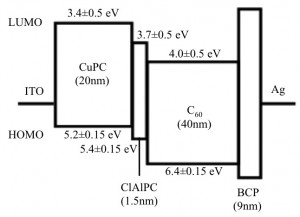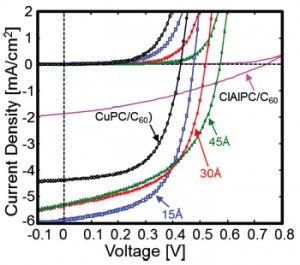Reducing Recombination Losses in Planar Organic Photovoltaic Cells Using Multiple Step Charge Separation
- Category: Energy, Optics & Photonics
- Tags: Jason Sussman, Marc Baldo, Tim Heidel
Organic photovoltaics (OPVs) are promising low-cost solar cells: they can be stacked in multi-junctions, and they are compatible with roll-to-roll processing. But as a solar cell’s installation costs are proportional to the area it covers, OPVs’ low efficiencies presently bar their widespread adoption. A significant source of loss in OPVs is the recombination of charges at the donor-acceptor interface: excited electrons combine with holes, returning the system to its ground state, rather than powering an external load. We therefore need to reduce the recombination rates in organic photovoltaics. We do so through spatial separation of electrons from the holes they leave behind when excited.
We enhanced the efficiency of heterojunction solar cells by introducing a thin layer of material between the donor and acceptor layers. Normally an exciton (a bound electron and hole created by light exciting the PV) splits at the donor-acceptor interface, but the electron and hole are still attracted to each other and often recombine. By adding an interfacial layer that creates an energy gradient for charges crossing the interface, we spatially separate the electron from its hole, reducing recombination rates and thereby improving efficiency. The structure has proven successful [1] .
- Figure 1: Energy level schematic for organic heterojunction photovoltaic device utilizing CuPC and C60. The ClAlPC layer provides a cascaded charge transfer from the CuPC donor layer to the C60 acceptor layer. From[1].
- Figure 2: Current density-voltage characteristics for CuPC/C60 photovoltaic devices with and without a ClAlPC interfacial layer. The control devices (black circle) have no interfacial layer. The insertion of a thin 1.5 nm interfacial layer (blue square) increases the short circuit current and the open circuit voltage. As the thickness of the interfacial layer is further increased to 3 nm (red diamond) and 4.5 nm (green triangle), the open circuit voltage increases but the short circuit current decreases. From[1].
- T. D. Heidel, D. Hochbaum, J. M. Sussman, V. Singh, M. E. Bahlke, I. Hiromi, J. Lee, and M. A. Baldo, “Reducing recombination losses in planar organic photovoltaic cells using multiple step charge separation,” J. Appl. Phys., vol. 109, 104502, May 2011 [↩]

